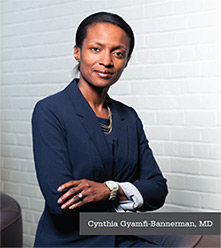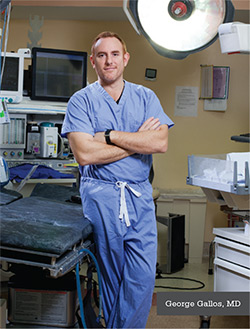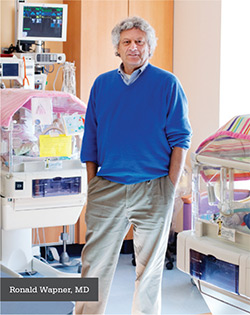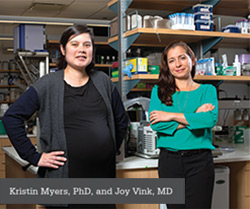Why Mothers Deliver Early – and How to Stop It
For most women, preterm birth, especially when it comes at the cusp of viability, comes out of the blue. “Everything is going fine, they’ve told everyone they’re pregnant and having a baby, and then all of a sudden they lose the pregnancy or deliver a baby who’s 500 grams and trying to survive in the NICU,” says Joy Vink, MD, a maternal-fetal medicine specialist and physician-scientist at Columbia. “It’s just devastating.”
And, for Dr. Vink, this obstetric dilemma is extremely frustrating. “Trying to console these couples and telling them we have no idea why it happens, and we don’t really have any good interventions, you just feel at a loss that you’re not able to help. That’s what drove me to do research,” Dr. Vink says.
Improvements in neonatal intensive care—and access to that care—have reduced the mortality rates of preterm babies in recent years, but decades of research have given clinicians like Dr. Vink relatively few options for preventing preterm birth or even predicting who will deliver early.
“We can treat life-threatening complications in pregnancy like heart disease and high blood pressure. We can call in surgeons to correct birth defects even before delivery. But we have not made a huge dent in preterm birth,” says Dr. Vink.
Preterm Birth Most Pressing Challenge in Obstetrics
Preterm birth is defined as delivery after 20 weeks and before 37 weeks of gestation, and last year, about one in every nine babies in the United States—more than 450,000 in all—was born too early.
Newspaper and TV stories of the miraculous recoveries of some preterm babies can give the impression that most preterm babies do fine after a stay in the NICU. But the data left out of these stories present a different picture. Preterm birth is the cause of about one-third of deaths in the first year of life in the United States, and early birth accounts for almost half of children living with cerebral palsy and 25 percent of children with cognitive impairment.
The later preterm babies are born, the fewer problems they have, but even those born just a few weeks shy of full term have higher rates of death and disability. Before 24 weeks, babies rarely survive without serious handicaps.
“Prematurity has long been acknowledged as the most pressing challenge in modern obstetrics,” says Ronald Wapner, MD, vice chair of research in Columbia’s Department of Obstetrics & Gynecology.
Why Does Preterm Birth Happen?
About 30 percent of preterm births are medically indicated, meaning they occur when the physician decides that delivering the baby early is safer for the mother and child than continuing with the pregnancy. Preeclampsia, intrauterine growth restriction, and placental abruption (when the placenta peels away from the uterus) are common reasons for delivering a baby early.

After three decades of rising preterm birth rates, the rate in the United States has steadily declined since 2006 when it peaked at 12.8 percent. The rate in 2013 was 11.4 percent, meeting the federal government’s Healthy People goal seven years early, but the rate is still nearly twice the rate of most European nations.
The decline is largely due to a decrease in the number of twin and triplet pregnancies produced from IVF, Dr. Wapner says, along with a concerted effort by the American College of Obstetrics and Gynecology to stop elective inductions before 39 weeks gestation. “We’ve picked the low-hanging fruit. To reduce the rate even more, we’re going to have to do more research.”
At Columbia, Dr. Vink and her maternal fetal medicine colleague, Cynthia Gyamfi-Bannerman, MD, are launching a center of excellence called the Preterm Birth Prevention Center. The goal of this center is to decrease the rate of spontaneous preterm birth by implementing standardized best clinical practice and performing cutting-edge translational and clinical research to better understand the complex pathways that lead to spontaneous preterm birth. Nationwide, only a handful of centers of excellence in preterm birth exist, and most focus solely on research. Columbia’s center will be the only center of excellence in the Northeast that provides both specialized patient care to women at risk for spontaneous preterm birth and access to cutting-edge research.
Columbia is part of the NIH’s Maternal Fetal Medicine Units Network, a group of 14 academic institutions that work together to identify evidence-based, cost-effective practices in obstetrics, particularly for preterm birth.
Columbia researchers also participate in an effort launched by the March of Dimes that has created new teams of scientists—all with different expertise—to approach the problem from fresh angles. (Columbia teams with the Prematurity Research Center at the University of Pennsylvania.) “We need to look at this problem in the same way we do Alzheimer’s disease,” says Dr. Gallos. “We’re now realizing that what happens in the uterus affects health later in life and even in future generations. From what we eat, to environmental exposures, that programming sets the tone even for your grandchildren. If we can solve preterm birth, we get 70 to 90 more years of life and potentially prevent many long-term consequences for multiple generations.”
The causes behind the other 70 percent, the so-called “spontaneous” preterm births, are often mysterious. The lack of answers and the magnitude of the problem make spontaneous preterm birth probably the most studied problem in modern obstetrics. Many of the studies have identified factors that raise the risk of having a preterm birth.
Previous preterm birth is the strongest predictor of who will deliver preterm. Carrying twins or triplets is another strong indicator: About 60 percent of twins are born preterm, and nearly all triplets come early. Other recognized factors that increase risk are race, age (younger or older), short interpregnancy interval, jobs that require long periods of standing, smoking, late or no prenatal care, certain vaginal bacteria, stress, low socioeconomic status, and even periodontal disease.
“Disappointingly, the vast majority of trials that we have done to modify these factors and prevent preterm birth have not been successful,” says Dr. Wapner.
Bed rest, home monitors for detecting premature contractions, increasing the availability of prenatal care to low-income women, and antibiotics have all proved ineffective.
Progesterone is the only intervention that has been shown in clinical trials to delay preterm birth, but only in women who have a history of preterm delivery and/or a short cervix. It also has been shown to be effective in preventing recurrent preterm birth.
“It’s a hard problem and it’s highly unlikely that one single intervention is going to make a giant difference because preterm birth is caused by so many different things,” Dr. Wapner says. “To get to the root of it we’re going to have to understand it better.”
What’s a Normal Pregnancy Anyway?
Part of understanding what goes wrong in preterm birth is understanding what goes right in a normal pregnancy.
“Coming up with interventions is challenging when we don’t even understand the fundamentals,” says Dr. Vink. “Once we understand what normal is, and how preterm birth is different, then we can find new medications or other ways to prevent the process from happening.”
For example, drugs designed to stop contractions in preterm labor on average only delay progression of labor for 48 hours. Dr. Vink and her colleague, George Gallos, MD, an obstetric anesthesiologist and physician-scientist at CUMC, think that a failure to understand the way the uterus and cervix work together might explain why these drugs, called tocolytics, ultimately fail.
Despite the longstanding observation that successful labor relies on well-coordinated uterine contractions, the search for a coordinating center (like the pacemaker in the heart) that orchestrates individual muscle cells to contract together in a regular, rhythmic fashion has remained elusive and mired in controversy. While a pacemaker-like cell has been hypothesized to exist in the uterus, Drs. Vink and Gallos have found new evidence that the cervix may participate in this process. “The cervix was previously thought of as a passive participant in birth, but we’re finding signs that it’s more of an active participant,” says Dr. Vink.
The first sign was Dr. Vink’s discovery of smooth muscle cells in the upper aspect of the cervix. Just like muscles in the uterus, these cervical muscles start contracting when bathed in a solution of oxytocin and stop contracting when tocolytics are added.
“We had to use higher concentrations of the tocolytic to stop contractions in the cervix than to stop contractions in the uterus,” Dr. Vink says. Could it be that tocolytics do not work in women because they do not fully quell contractions emanating from the cervix? These questions are currently investigated in Dr. Vink’s and Dr. Gallos’ laboratories.

The Role of the Microbiome
Infection and inflammation are among the causes of preterm birth that have been known for decades. Infection has been implicated in more than 85 percent of spontaneous preterm births that occur before 28 weeks. “Infection can be a problem in the really early preterm births, the 24- to 27-weekers,” says Dr. Wapner. “The earlier the delivery, if you look at the placenta, you’ll often see infection.”
And it is possible that infections—or just certain microbial milieus—are causing many more. “The true prevalence may be grossly underestimated since some microbes may cause clinically silent infections and until recently we could not detect many others,” neonatologist Tara Randis, MD, says.
Microbes that invade the uterus are typically present in the vagina, and most infections are thought to occur after they ascend and pass through the cervix. (Some infections may be seeded by microbes from other body parts, including the mouth, a possibility other Columbia researchers are investigating.)
But if the bacteria are often there, why do some women get infections and some do not? Obstetricians started to notice that infections were more common in women with a condition called bacterial vaginosis (BV).
The typical microbiome in the vagina is dominated by aerobic lactobacilli. In BV, an array of anaerobic microbes takes over, sometimes producing a foul-smelling discharge but often producing no symptoms at all.
BV is very common, affecting about one in five pregnant women. “It’s hard to call this a disease with such a high prevalence, but if you look at women with BV, they have a two-fold higher risk of preterm birth even if they don’t have any symptoms,” says pediatrician and researcher Adam Ratner, MD, who worked with Dr. Randis until both moved this year to NYU. (Dr. Ratner, a 1998 P&S graduate, and Dr. Randis will continue to collaborate with P&S researchers.)
Many clinicians had hoped that treatment for BV would reduce preterm birth, but results from several large clinical trials that tested antibiotics proved disappointing. The rates did not budge.
“I don’t think further interventions aimed at BV are likely to succeed, until we know more about how BV leads to preterm birth,” Dr. Randis says.
Researchers hope a new mouse model of BV developed by Drs. Ratner and Randis will start to provide some answers. Previous attempts to model BV in mice have failed, but the new model is the first that is able to carry G. vaginalis, thought to be one of the main bacterial culprits of BV.
With the new mouse model, Drs. Randis and Ratner discovered that an enzyme can reduce the numbers of vaginal G. vaginalis, by cutting through the external DNA in the protective biofilm created by the microbe.

“Antibiotics may have failed to reduce preterm birth in previous trials because they couldn’t penetrate this biofilm,” Dr. Randis says. “It raises the possibility of using the enzyme to prevent or treat bacterial vaginosis, either alone or in combination with antibiotics, and see if that reduces preterm birth.”
But the problem may be more complicated than taming the activity of one microbe.
“What we’re now learning is there’s tremendous variation in the microbiomes of healthy people,” Dr. Ratner says. Not only does the microbiome vary from woman to woman, some microbiomes change with a woman’s menstrual cycle, some stay steady, and others fluctuate randomly. “How can we take one sample from one person and determine if they’re at risk for preterm birth? We’re really just at the beginning of understanding.”
Cervical Reinforcements
“If we had a tool that could more accurately predict a patient’s chance of delivering preterm, it would change the way we do preterm care.”
Regardless of what initiates the process of a preterm, or even a normal, birth, the baby can not exit the uterus until the cervix softens and opens. The cervix during pregnancy is the mechanical barrier that keeps the growing fetus in the uterus until term, says Dr. Vink. “If you think of the uterus as a balloon, filled with pressurized air, the knot at the bottom of the balloon is your cervix, keeping all the air in. It is this knot that has to stay strong for nine months, but if the knot is too soft, it will eventually dilate early and can lead to preterm birth.”
Though the most dramatic changes happen just a few hours before birth, the cervix begins to soften in the first trimester of a normal pregnancy. (Before blood and urine tests were developed, doctors in the 1800s used this softening to detect pregnancies as early as six weeks into the pregnancy.)
By the second trimester, the cervix softens—imagine the knot of the balloon shrinking in size—to about 30 mm long. Over the course of the third trimester, the cervix continues to gradually shorten.
“Once you get below 25 mm (if you have a history of preterm birth), you’re at risk for a preterm birth,” Dr. Vink says. (It’s 20 mm for women with no history of preterm birth.) “And the shorter you go, the higher the risk.” About a quarter of women with a cervix shorter than 25 mm will deliver before term; about half will deliver preterm when the cervix shrinks to 15 mm or less.
Columbia physicians now do cervical length screening at the same time they do the anatomical survey, between 18 to 20 weeks gestation, because a 2007 landmark clinical trial showed that a daily progesterone gel reduces preterm births in women with short cervixes and singleton pregnancies.
Normally progesterone—the term itself means “pro-gestation”—is key in maintaining the pregnancy and preventing the uterus from contracting, though it is still unclear how the additional progesterone given to women with short cervixes works to prevent preterm birth.
Another option, backed by some studies, is a cerclage—a suture stitched around the diameter of the cervix. Resembling a purse string, the stitch is drawn tight to keep the cervix closed.

“The hope with a cerclage is to keep the cervix closed until term when we take out the stitch and let labor progress normally,” Dr. Vink says. “But it is a procedure that requires anesthesia and going to the operating room, and you’re putting needles into the cervix close to the amniotic sac. It’s not without risk.”
Some doctors try a less invasive option, a doughnut-shaped silicone device called a pessary that is inserted in the vagina and fitted around the cervix. The device was originally designed decades ago to prevent pelvic organ prolapse.
“It’s thought that the pessary changes the angle of the cervix so that there is less pressure on it from the uterus and the fetus,” Dr. Wapner says, “but whether it works is still controversial. Some studies say it’s perfect and others say it doesn’t make a big difference. The truth is probably somewhere in between: There’s probably a group of women it will work for, and a group it won’t work for.”
An Engineer’s View of Pregnancy
The idea that a pessary changes the forces of pregnancy intrigues—and bemuses—mechanical engineer Kristin Myers, PhD. “It’s supposed to support the cervix, but no engineer has looked at it,” she says.
Dr. Myers studied engineering in college, expecting to get a job in industry designing automobiles, airplanes, or robots. She spent summers interning at General Motors and then joined the company to design automatic transmissions. Soon she was looking for something more fun and rewarding and pursued a doctoral degree in biomechanics. She joined the Department of Mechanical Engineering at Columbia in 2010 and soon started collaborating with Dr. Vink and Dr. Gallos.
“I think of pregnancy in terms of structure and materials,” Dr. Myers says. “The baby, to me as an engineer, is a sack of sticky material and a mechanical load.”
It’s a relatively new—and difficult—way to look at pregnancy. “Compared to steel or wood, the cervix is a dynamic structure. It changes its composition over time,” Dr. Myers says. “The uterus is growing and stretching during pregnancy; that’s what we’re trying to model. We can then look for areas of high stress. That’s where you’re going to have failure.”
Using the same type of computer modeling used to design new aircraft, Dr. Myers and her students get data on the shape of the cervix and the uterus from ultrasound scans of Columbia patients during different stages of pregnancy. They then take into account each organ’s physical properties and how they change over time, data that are a little trickier to obtain. “Taking tissue samples from pregnant women is, you might imagine, difficult,” Dr. Myers says. Some samples are available from women undergoing cerclage or when a pregnancy is terminated, but the engineers are using new ways to measure cervical properties, including a small vacuum tube developed by engineering researchers in Switzerland at the Swiss Federal Institute of Technology in Zurich.
“When you press the end of the tube to the cervix—it’s about a quarter inch in diameter—the vacuum sucks a bit of tissue into the tube,” she explains. “You can measure physical properties of the cervix depending on how much tissue is sucked up and how quickly.”
Dr. Myers’ students and postdocs are also using optical imaging, a tool developed by electrical engineer Christine Hendon, PhD, to determine how collagen fibers in the cervix are arranged.
“We then ask, using the computer model, what happens if the architecture of the fibers changes? Does that affect the load on the cervix? Or what about the shape of the pelvis?” Dr. Myers says. “There’s a lot of complex biophysics going on, but for the first time we’re able to see what happens with all these variables.”
Dr. Myers’ graduate students, Michael Fernandez and Andrea Westervelt, are now using the computer model to look at the effects of the pessary on the cervix. “We’re seeing that the pessary closes the cervical canal, but at a cost,” Dr. Myers says. “You have to put a mechanical force on the cervix to close it, and we don’t know if that mechanical force is detrimental. We think for some women, it may be making things worse, and for others the benefit of realigning the cervix to reduce forces in other locations may be beneficial. Hence, a personalized approach to understanding each patient’s biomechanical environment is critical to restoring mechanical function.”
The computer model has produced other surprises, including the unexpected importance of the fetal membranes in carrying the load. In a healthy pregnancy, the membranes stick to the inside of the uterus. “What we’ve discovered is that the load on the cervix is a lot lower when the two adhere to each other than if membranes are allowed to slide around,” Mr. Fernandez says. “In some cases the load on the cervix is double; it can be really drastic, which is amazing because the membrane is really thin. The load bearing part is one-tenth of a millimeter thick.”
Dr. Myers speculates that the extra load on the cervix may trigger the cervix to soften, potentially explaining why the separation of the membranes is known to increase the risk of preterm birth. “This study has really opened our eyes to the other components—the uterus, the membranes—that all carry the load.”

Big Data for Better Predictions
Except for being able to predict preterm birth in some instances (multiples being the most common example), physicians are no closer to accurately predicting whether their patients will deliver early despite decades of research into the factors that predict the risk of preterm birth.
“Right now we have to treat everyone as if they are at risk,” Dr. Wapner says. “Even if a woman comes in at 32 weeks with regular contractions, we can’t tell if she’s going to deliver preterm or if the contractions will stop on their own. A better prediction tool would help us pay the appropriate amount of attention to the patients who need it most.”
Machine learning and new mathematical techniques may be able to help, says computational scientist Ansaf Salleb-Aouissi, PhD, a member of the Data Science Institute on the Morningside campus.
Dr. Salleb-Aouissi started out applying machine learning techniques to geological data; her interest in preterm birth started when her second child developed colic. “I thought we could use electronic health records to tease out the causes, but it turns out there are not many good EHR datasets for colic,” she says. “A few people on my team had experienced preterm birth and when we realized there was enough EHR data to support a study, we approached Dr. Wapner.”
Dr. Wapner was able to get Dr. Salleb-Aouissi access to data from the NIH preterm prediction study, which collected data from approximately 3,000 women.
Though many risk factors have been identified for preterm birth, clinicians mainly consider only two: Has the woman had a prior preterm birth and does she have a short cervix? “Our perspective is to combine all the factors, use sophisticated machine learning techniques, and ask how they blend together to lead to preterm birth,” says Dr. Salleb-Aouissi.
Machine learning techniques, which are used to analyze data in everything from self-driving cars to spam detectors, are able to tease out much more complex relationships in the numbers than simple linear regression techniques, Dr. Salleb-Aouissi says.
Her first attempt with machine learning techniques, using the preterm prediction study data, was able to correctly predict preterm births about 50 percent to 60 percent of the time, an improvement from an older linear analysis with 20 percent to 30 percent accuracy, but not yet good enough for clinical use.
George Gallos, MD, assistant professor of anesthesiology
Cynthia Gyamfi-Bannerman, MD, associate professor of obstetrics & gynecology at CUMC
Christine Hendon, PhD, assistant professor of electrical engineering
Kristin Myers, PhD, associate professor of mechanical engineering
Tara Randis, MD, former assistant professor of pediatrics at CUMC
Adam Ratner, MD, former associate professor of pediatrics
Ansaf Salleb-Aouissi, PhD, lecturer in discipline, computer science
Joy Vink, MD, assistant professor of obstetrics & gynecology at CUMC
Ronald Wapner, MD, professor of obstetrics & gynecology
“What the analysis tells us is that we can probably improve the prediction with a larger dataset,” she says. A dataset with 3,000 cases is not very big for machine learning purposes, and Dr. Salleb-Aouissi, with support from the National Science Foundation Smart and Connected Health program, is now working with a much larger EHR dataset of preterm births from NewYork-Presbyterian Hospital. New data from 10,000 women collected in the past few years from multiple centers around the country are becoming available and may provide Dr. Salleb-Aouissi with genetic data for the first time.
Preterm birth pushes the boundary of data-mining techniques—the processing is complicated by missing data and the imprecise nature of medical lingo—but Dr. Salleb-Aouissi thinks the problems can be solved.
“Physicians see that preterm births that happen at different times have different causes, but that temporal variability needs fancier techniques,” she says. “Ultimately, I feel that the problem of preterm birth prediction can be tackled with machine learning, and we may be able to achieve actionable sensitivity and specificity.”
“If we had a tool that could more accurately predict a patient’s chance of delivering preterm, it would change the way we do preterm care,” Dr. Wapner says. “For women not at risk, we could decrease the number of visits. We could decrease the number of ultrasounds. When they have contractions, we could say, ‘Don’t worry, you’re not at risk.’”
- Log in to post comments


